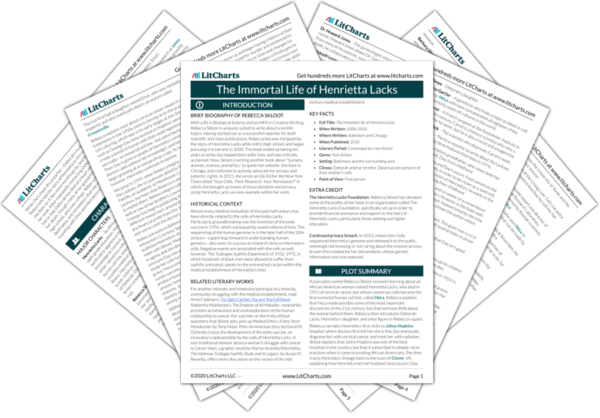Summary
Analysis
By the 1960s, HeLa is everywhere. Russian and American scientists have even grown them in space, in order to test the effects of spaceflight on human cells. They find that while cancerous cells grow normally in orbit, HeLa divides even faster.
Skloot continues to show how HeLa has impacted many landmark events of the twentieth century—even something seemingly unrelated to cellular biology like space travel.
Themes
Scientists have also begun noticing two things about cultured cells: first, it looks like all cells growing in culture either die or become cancerous. Researchers have also found that once they become malignant, all cultured cells—even different cells—begin behaving in exactly the same way. Scientist Lewis Coriell speculates that HeLa is contaminating other cells. At this time, scientists are finding it fairly easy to culture cells from different parts of the body. Using these cells, they are making groundbreaking discoveries: that cigarettes caused lung cancer, that X-rays could make normal cells malignant, why cancer cells didn’t stop growing, and how chemotherapy drugs could destroy cancerous cells. Yet scientists don’t seem at all worried about contamination of their cultures, despite the fact that results will be worthless if they are working with the wrong cells.
Since discovering HeLa, the field of cell culturing has grown exponentially—in contrast to the Lacks family, which has encountered nothing but difficulty after difficulty. Now, however, the first major stumbling block in HeLa research comes up: contamination. Up until this point, scientists have cared little about whether their samples are mixing with each other—in contrast to Margaret Gey’s constant, relentless emphasis on cleanliness and sterility.
Themes
A meeting of prominent scientists decides that researchers must begin to take precautions against contaminants. The NIH, in response, creates a Cell Culture Collection Committee that includes William Scherer, Lewis Coriell, and Robert Stevenson, in order to create a cell bank at the American Type Culture Collection. They want to create “the Fort Knox of pure, uncontaminated cell culture.” All cells must be tested for contamination, and come from their original source.
It seems that the cell culturing research has grown so fast as to get out of hand, and now there needs to be a standardizing system to make sure the right cells are being used as intended.
Themes
The group contacts George Gey for a sample of the original HeLa culture. Gey, however, has kept no original HeLa for himself, and must contact Scherer for some of the original cells. The team begins testing samples for viral and bacterial contamination, but soon starts testing for cross-species contamination as well. They find that of “ten cell lines thought to be from nine different species” nine are all from primates.
That Gey has kept no HeLa for himself is even more proof of his immense, even irrational generosity. The group’s finding, meanwhile, is shocking—it means that scientists haven’t even been working with the correct species of cells, pointing to a staggering amount of carelessness and faulty data.
Themes
Get the entire Henrietta Lacks LitChart as a printable PDF.

In 1960, French researchers find that cells infected with certain viruses in culture will fuse, combining their genetic material. Though the technical term is “somatic cell fusion,” researchers name it “cell sex.” Rebecca explains that “genetically speaking, humans are terrible research subjects” because scientists can’t control our mating, and we don’t reproduce copiously. Cell sex solves this problem, because researchers can “combine cells with any traits they wanted and study how those traits were passed along.”
Skloot continues to give more background scientific and historical info necessary to later points she will make about HeLa.
Themes
In 1965, two British scientists—Henry Harris and John Watkins—combine HeLa with mouse cells. They also fuse HeLa with chicken cells that can no longer reproduce, and find that HeLa allows the cells to replicate once again. This means that something within cells can regulate genes. If scientists can find a way to turn disease genes off they may be able to “create a form of gene therapy.” Researchers at NYU discover that human-mouse hybrid cells gradually lose their human chromosomes, meaning that scientists can map “human genes to specific chromosomes by tracking the order in which genetic traits vanished.” The press condemns the research, speculating that scientists are creating hybrid man/animal monsters. The public comes to believe that research of this type is “pointless and dangerous.”
So far during this narrative the press has often been misguided and has reported misinformation when it comes to Henrietta and her identity. Here we witness how the press is often wrong about scientific progress as well, sensationalizing, demonizing, and simplifying complex medical discoveries. What the press perceives as monstrous is actually something closer to miraculous, in that it leads to the ability to analyze a person’s genes—an innovation that will eventually allow scientists to identify and treat genetic diseases.
Themes












